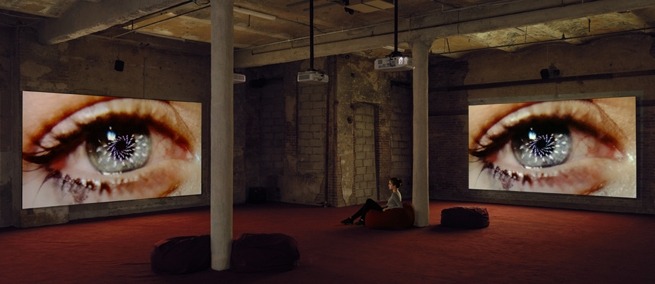
At the New Museum in lower Manhattan, British artist Marianna Simnett’s five-channel video work “Blood In My Milk” has just opened. Simnettt's video work explores the way that systems work such as the nasal cavity, a cow's udder, and surgical procedures. "Blood In My Milk" is a feature-length cut of four of Simnett’s fable-like videos: THE UDDER (2014), BLOOD (2015), BLUE ROSES (2015), and WORST GIFT (2017). We sat down with Simnett after the exhibition opened on September 4. It will be on view through January 6, 2019.
Science & Film: How did your interest in science emerge?
Marianna Simnett: I am interested in procedures and violence and sensations more than hard science. I like working with surgeons, I like working with people who work with bodies and penetrate the skin. They are my favorite characters. I like casting them. I like finding them. As you can see, they’re in all of my work. I’ve worked with farmers, surgeons, scientists, engineers, and roboticists, many of whom are working with integrated technological and biological systems, which is the area I find most interesting. They’ve become my muses in recent years.
S&F: One thing that I noticed in “Blood In My Milk” is a tone of skepticism towards the medical-scientific enterprise. How did that tone develop?
MS: We submit ourselves to others who are supposed to have the knowledge to cure us from whatever ailment we think or we’re told that we have. Cuts to the National Health Service in the UK have caused healthcare resources to radically drop, and quality of care is at stake. This is a pressing issue in the UK and US, and doctors are often demonized as part of a larger problem.
There is a difference between addressing the global problem of healthcare and working with a doctor who is an individual person and not just an archetype. I think my work attempts to bridge that gap. I don’t write the role of a doctor and then get an actor to fill it, I meet a person and incorporate their idiosyncrasies. Dr. Costello, the voice surgeon in WORST GIFT, is also a professional tenor; Dr. Mark Whiteleyis a vascular surgeon; Dr. Hong Liang is a robotic enginee; and Emma is a mother and a farmer—and not just any farmer, that farmer. I get to know them and I interview them about their lives and professions. In the work, there is this language of genuine care, but also a sense of impending doom.
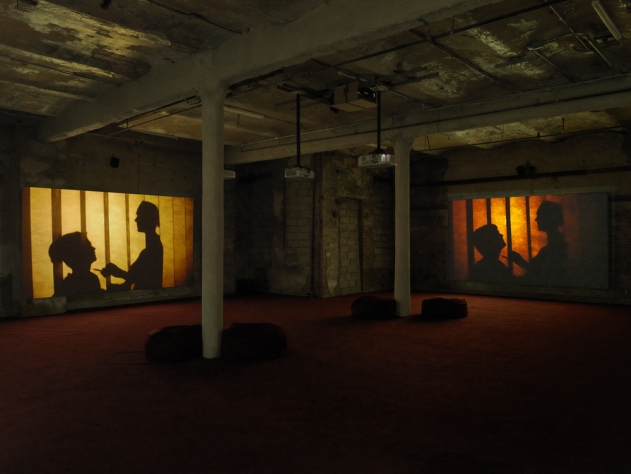
S&F: Can you say more about the language of genuine care and what you mean by that?
MS: There is that sickly sweet, highly trained language of care that sounds genuine but is so procedural and routine that it might as well be coming from a robot. I get really attracted to that because I’m like, but do you mean it? Why are we talking like this?
S&F: When you say sickly sweet, I think about bedside manner in which some doctors are trained. Are you questioning the use of it?
MS: Yeah. I overuse it in the work; there is a lot of that language.
S&F: The technical language that you use also stood out to me.
MS: I mean, if my films weren’t so absurd … [laughs] I don’t think you read my films as truth or an attempt to discover truth. I explore magical biological systems from a curious perspective. So without the work being educational or didactic, there is a lot in there that is showing us the way our bodies work, how we digest things, and what happens on the inside. Like, mastitis. A cow can’t produce milk unless there is oxytocin; it is the same process that women go through when they breastfeed. I’m not a scientist but I have intimate knowledge of the nasal cavity and the vascular system—the way blood moves around the body. I know how to force unconsciousness. I know about mammary glands and milk ducts and things like that. I know about theories like Wilhelm Fleiss who talked about the homology between the nose and genitals that comes from Freud’s experiments.
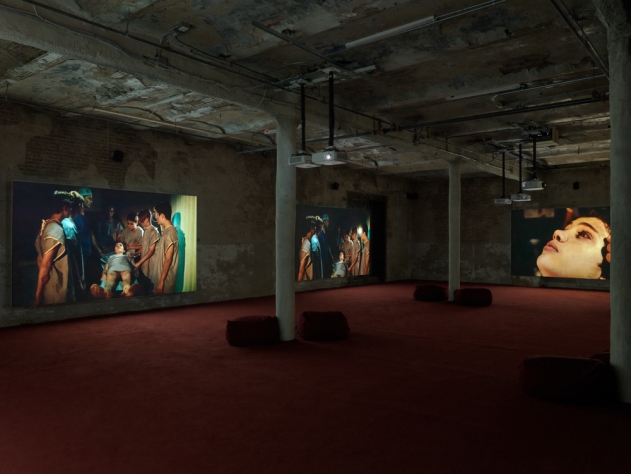
S&F: What sort of research do you undertake for these films?
MS: I follow my nose. I get interested in a sensation or feeling—of an udder becoming a phallus and a nose—and then I discover stories about hysteria and menstruation. I don’t know how I find things; by asking and reading and drawing. It’s driven out of the characters I find—the people and their stories also influence the film very much. A lot of the words in “Blood In My Milk” like, “we eat eels every day,” or “the puppy bit the tape,” or “Brian bored me over dinner,” these are alliterative vocal exercises for patients with voice disorders. Some of the language [in my work] comes from sitting in the clinic. The surgeon will allow me to sit all day long watching him inject patients. I’ll just be note-taking all the time. Some of it, not a lot, will make its way into the script.
S&F: Have you ever felt the need to have an official scientific advisor?
MS: If I had someone official I don’t think I’d get as far as I do. I have a kind of relentlessness about me. I won’t stop. Others maybe would. Part of my story is about trying to get past guards, trying to get past authority.
S&F: How did you meet Dr. Costello, the voice surgeon who is in the film?
MS: I wanted to get my voice lowered and Dr. Costello was recommended. He refused [to do the procedure], but sent me to his colleague who works with patients undergoing gender reassignment, who lowered my voice temporarily using Botox.
I always interview people when I meet them just like you’re doing to me, so I interviewed Dr. Costello and he told me he was a singer, so I asked if I could watch him working in both professions; I went to the church and I went to the hospital. I made a separate film in 2016 called THE NEEDLE AND THE LARYNX which documents me changing my voice.
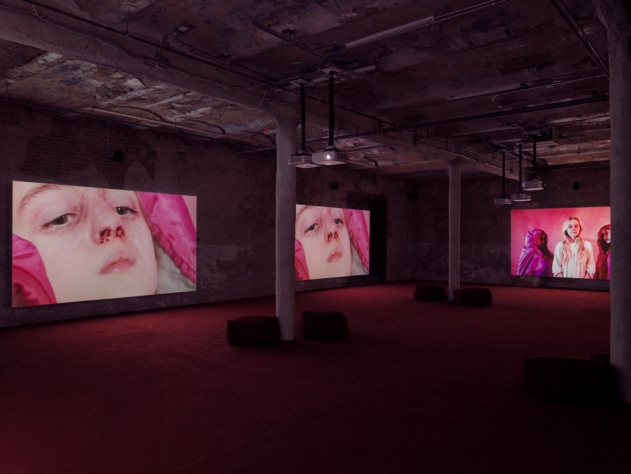
S&F: You wanted to change your voice for research or for the film?
MS: It was both. I don’t have many divisions between my life and my work.
S&F: Did you always want to act in your films?
MS: I’ve always been very entwined [with my work] even if I’m not physically present in it. I wear my process on my sleeve. You can see the blood going to my head in one of the films. You can see me breaking past the guard by cursing him with birds that peck his dick off. I mean, okay, I exaggerate things but basically I’m describing what happens in my process.
S&F: Watching your installation reminded me of body horror films, like those by David Cronenberg. Are you a fan?
MS: I love his films. Just pure joy. He theatricalizes the body and pushes it to the point of explosion, and you really feel it—however artificial. The head explosion in SCANNERS was just a dummy head stuffed with stringy bits and leftover burgers. The screen enables you to perform excess and unkindness upon bodies.
S&F: In an unexpected way too, it seems to me.
MS: I have a worm crawl out of my mouth, exploding legs, cockroaches, needles, there is a lot of phobic imagery in my work.
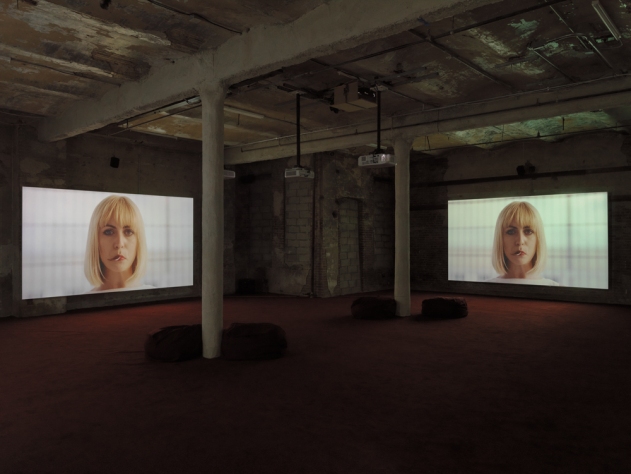
S&F: How do you feel about the work being installed in a museum setting, where people can walk in and out?
MS: Oh that’s good; I designed it so people can walk in and out. It’s not good for everyone’s stomachs. I’ve watched a lot of people walk out on the same scene, which is this pretty standard endoscopic footage of a turbinectomy [the official name], and ten people at a time walk out. I understand. It would be mean to trap them in there and lock the door.
The piece covers many moods, from sweet and innocent to brutal violations of the body. I think a museum is the best place for it, actually. I’m working with eery institutions in the films, so it makes sense to set it in an environment that doesn’t get off scot-free.
S&F: What do you think about the way “Blood In My Milk” is exhibited?
MS: I love the space at the New Museum. The five screens are synchronized, showing multiple viewpoints of a singular narrative. The red carpet was a deliberate decision because color is really important in my work—each film has a different palette. One is flesh-like, one is a very horrific, garish pink, or deep blue. These colors pertain to the language of the body. “Blood In My Milk” needed a carpet that was going to unite all the works together and not just be a functional, institutional carpet but was going to start to move beyond that into the space and into the interior spaces of the films themselves. I wanted it to be the glue. Also, I like people being really comfortable because if you’re comfortable then you get frightened more easily. And I like to frighten people. If you put people on a cold, concrete floor, it’s too close to the severity in the films. It’s important to get someone comfortable before addressing a difficult subject.
“Blood In My Milk” is on view at the New Museum of Contemporary Art in Manhattan through January 6, 2019. The exhibition is curated by Helga Christoffersen, Associate Curator at the New Museum. Marianna Simnett lives and works in London. Her work has been shown by galleries including Seventeen Gallery and Whitechapen Gallery, at the 2018 Athens Biennial, the Walker Art Center in Minneapolis, and the Bergen Kunsthall in Norway. She has forthcoming shows at the Museum für Modern Kunst in Frankfurt and at E-Werk in Freiburg, Germany. For more, read our write-up of her short film THE UDDER.
All images credit: “Marianna Simnett: Blood In My Milk,” 2018. Exhibition view: New Museum, New York. Photo: Maris Hutchinson / EPW Studio
TOPICS